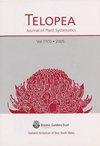Redescription of the suspended aquatic Utricularia aurea Lour. (sect. Utricularia) and a new species U. adamsii for northern Australia
IF 0.5
4区 生物学
Q4 PLANT SCIENCES
引用次数: 2
Abstract
Australia has seven species in Utricularia L. section Utricularia, with the habit for all members of either affixed or suspended aquatic. Of the six recognised Australian species, one is endemic, one is pantropical, three are also distributed across Asia or Papua New Guinea - with U. australis R.Br. extending into Europe, and one other, U. stellaris L.f. into Africa. We present a molecular phylogeny based on two plastid and the nuclear ITS sequences for members of the subgenus Utricularia representing U. aurea Lour. and closely allied species from across each of their distributions. The molecular phylogeny provides strong support for recognition of a new species Utricularia adamsii R.W.Jobson & Davies-Colley (Lentibulariaceae), here described as new member of section Utricularia. This taxon was previously included within U. aurea, however, our molecular phylogeny and morphology supports a sister relationship with U. muelleri Kamienski. We provide a revised concept of U. aurea, and a description of the new species. The morphological differences between U. adamsii, U. muelleri, U. aurea and closely related species are here discussed, and an identification key provided. Distributions and habitat preferences of these taxa are discussed.水生悬浮木藻(Utricularia aurea Lour)重新描述。澳洲北部的一新种(水藻属)
澳大利亚有七种水蛭属水蛭科,习性为所有成员或贴或悬水生。在澳大利亚已知的六种中,一种是地方性的,一种是泛热带的,三种也分布在亚洲或巴布亚新几内亚-与U. australis R.Br。延伸到欧洲,另一种是美国的恒星延伸到非洲。我们基于两个质体和核ITS序列对代表U. aurea Lour的Utricularia亚属成员进行了分子系统发育。以及分布在不同地区的近亲物种。分子系统发育为确定一新种Utricularia adamsii R.W.Jobson & Davies-Colley (lentibullariaceae)提供了强有力的支持,并将其列为Utricularia科新成员。这一分类群以前曾被包括在U. aurea中,然而,我们的分子系统发育和形态学支持与U. muelleri Kamienski的姐妹关系。我们提供了一个修订的概念,并对新物种的描述。本文讨论了adamsii、uelleri、uaurea及其近缘种在形态上的差异,并给出了鉴定钥匙。讨论了这些分类群的分布和生境偏好。
本文章由计算机程序翻译,如有差异,请以英文原文为准。
求助全文
约1分钟内获得全文
求助全文
来源期刊

Telopea
PLANT SCIENCES-
CiteScore
1.30
自引率
42.90%
发文量
0
期刊介绍:
Manuscripts submitted for publication in TELOPEA are published online, after peer review and acceptance by the TELOPEA Editorial Committee and when final editorial formatting has been completed. The journal specialises in plant systematics and phylogeny. The geographic scope of the journal encompasses Australia, Malesia, Melanesia, Micronesia, and Polynesia. The suitability of a work for the journal depends on the topic and the region of origin, generally the narrower the focus of the manuscript the closer to New South Wales must be its geographic focus.
As a general guide, we will consider:
1) revisionary treatments and other substantial bodies of work from any of the regions mentioned above.
2) new species from any Australian state.
3) new country records for Australia from any state.
4) new state records from New South Wales only.
However, we aim to support botanical research across the broader Australasian and Pacific region, and will consider submissions on their merit.
Generally we will not consider extraterritorial new country records, or single lectotypification papers unless they pertain to New South Wales taxa, or have significant bearing on the Australian flora.
 求助内容:
求助内容: 应助结果提醒方式:
应助结果提醒方式:


